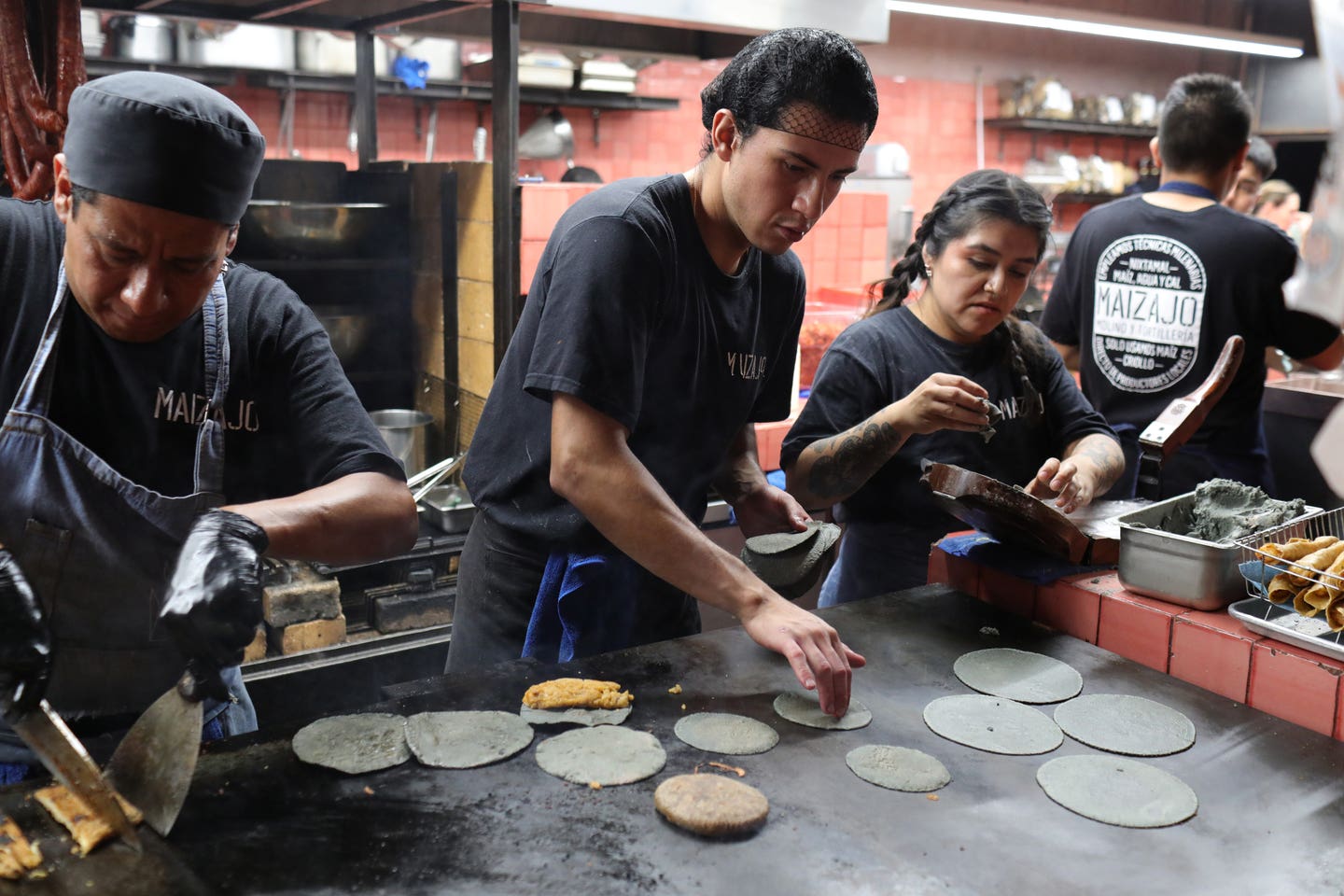
The Top 12 Tacos of Mexico City—And Where to Try Them
Whether you’re in the mood for carnitas, birria, or Cantonese-inspired pork belly, our resident taco expert knows exactly where to send you.
In Mexico City, no matter where you are, you’re steps from a taco. That unmistakable aroma of grilled meat, chiles, onions, and earthy corn tortillas may emanate from a busy street stand or hole-in-the-wall shop, its walls blackened by decades of smoke. Or maybe the scent is coming from a corner vendor hawking blue corn squash blossom quesadillas, or from a market stall known for its tacos de guisados (topped with saucy stews).
Tacos are an integral part of daily life from the Southwestern U.S. to Central America, but in Mexico, they’re so omnipresent that the phrase “echarse un taco” (to down a taco) is shorthand for “let’s grab a bite.” Much of Mexican gastronomy has been influenced by immigrants from Europe and beyond, but corn tortillas have been consumed here since pre-Hispanic times, and the idea of wrapping food in them precedes written history. The taco is ingenious—it is plate, fork, and spoon. Its three elements—tortilla, filling, and salsa—need to be well crafted and of high quality as balance is the key to a great taco.
Tacos were originally sold from carts or baskets by itinerant vendors, but the earliest taquerías (restaurants specializing in tacos) appeared around the turn of the 20th century. Many of my favorite places go back to the 1940s and ‘50s. While the earliest venues usually specialized in the aforementioned guisados or simple grilled meats, the midcentury influx of Lebanese immigrants introduced the now iconic tacos al pastor, a fusion of spit-roasted shawarma with local ingredients. And recently, a new generation of chefs have begun highlighting local, seasonal produce that speaks to tradition and frequently incorporates foreign flavors.
Even in the taquería mecca of Mexico City, not all tacos achieve greatness, but the ones served at these, my favorite haunts, always do.
Taco de rib-eye at Taquería Los Parados
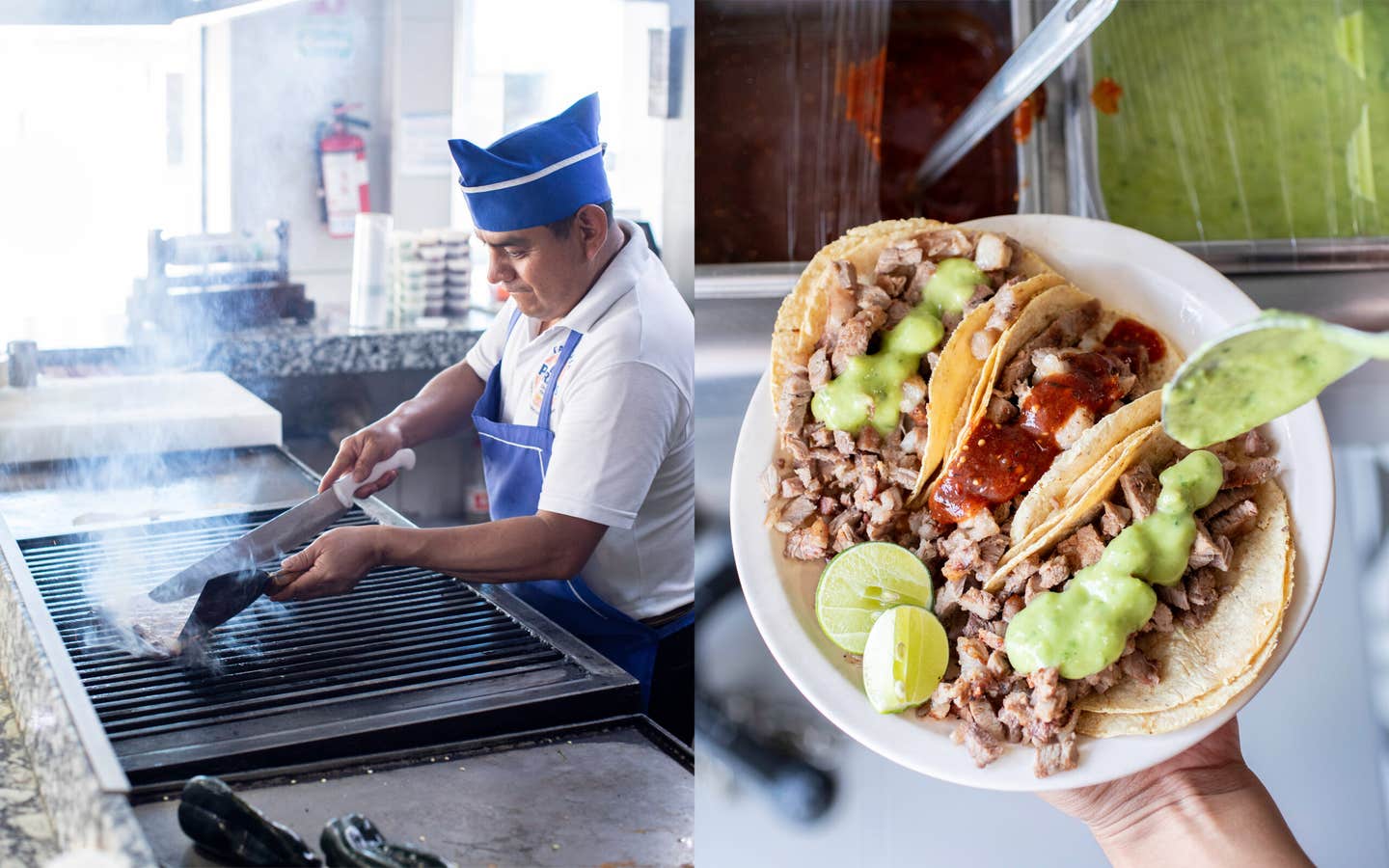
Los Parados is, as its name implies, a standing-room-only hangout and a Mexico City institution. Tacosal carbón(cooked over coals)are the specialty, and the smoky aroma seduces patrons from half a block away. I’ve tried everything on the menu, but the rib-eye is the winner. Strips of tender, marbled meat come charred and juicy on a soft tortilla accompanied by ruby red tomato-guajillo and fresh green tomatillo salsas served out of big molcajetes (volcanic stone mortars). Local office workers congregate here during the day, while the late-night hours attract a motley cross-section of tired club patrons, off-duty workers from the nearby hospitals, and policemen who assiduously devour tacos by the plateful.
Taco de mole verde at Taquería El Jarocho
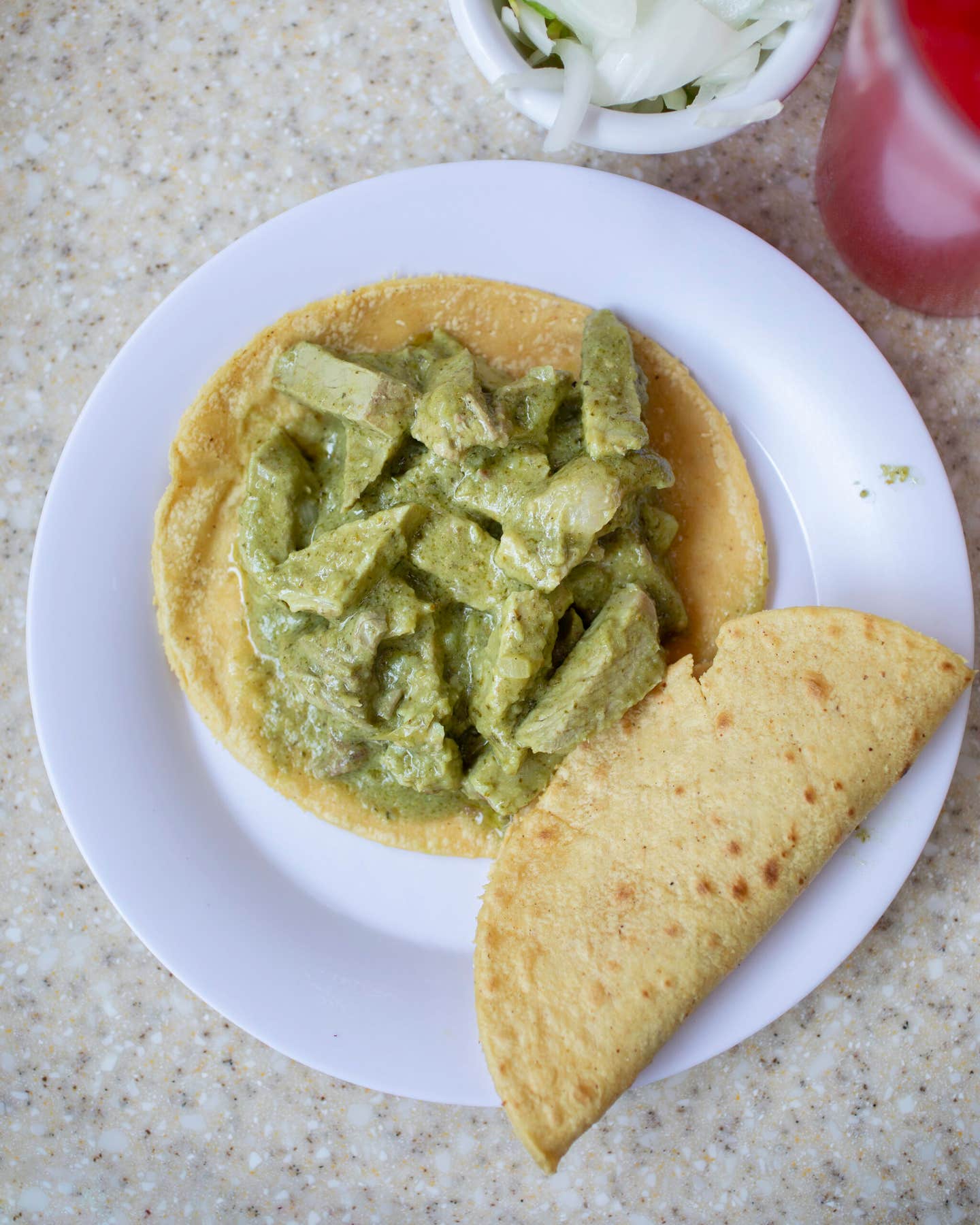
This Colonia Roma landmark, in business since 1947, specializes in tacos de guisados. My repeat favorite is the mole verde: tender pork swathed in a luxuriant jade green sauce made with pumpkin seeds and the anise-like Oaxacan herb hoja santa. There are always a few vegetarian options as well, such as the old standards, poblano chiles in cream, or eggs in tomato sauce. While the prices are high for Mexico City, each taco comes topped with an extra tortilla, so it’s really a two-for-one. Rice-based horchata is the libation of choice.
Taco campechano of rib-eye and longaniza at Maizajo
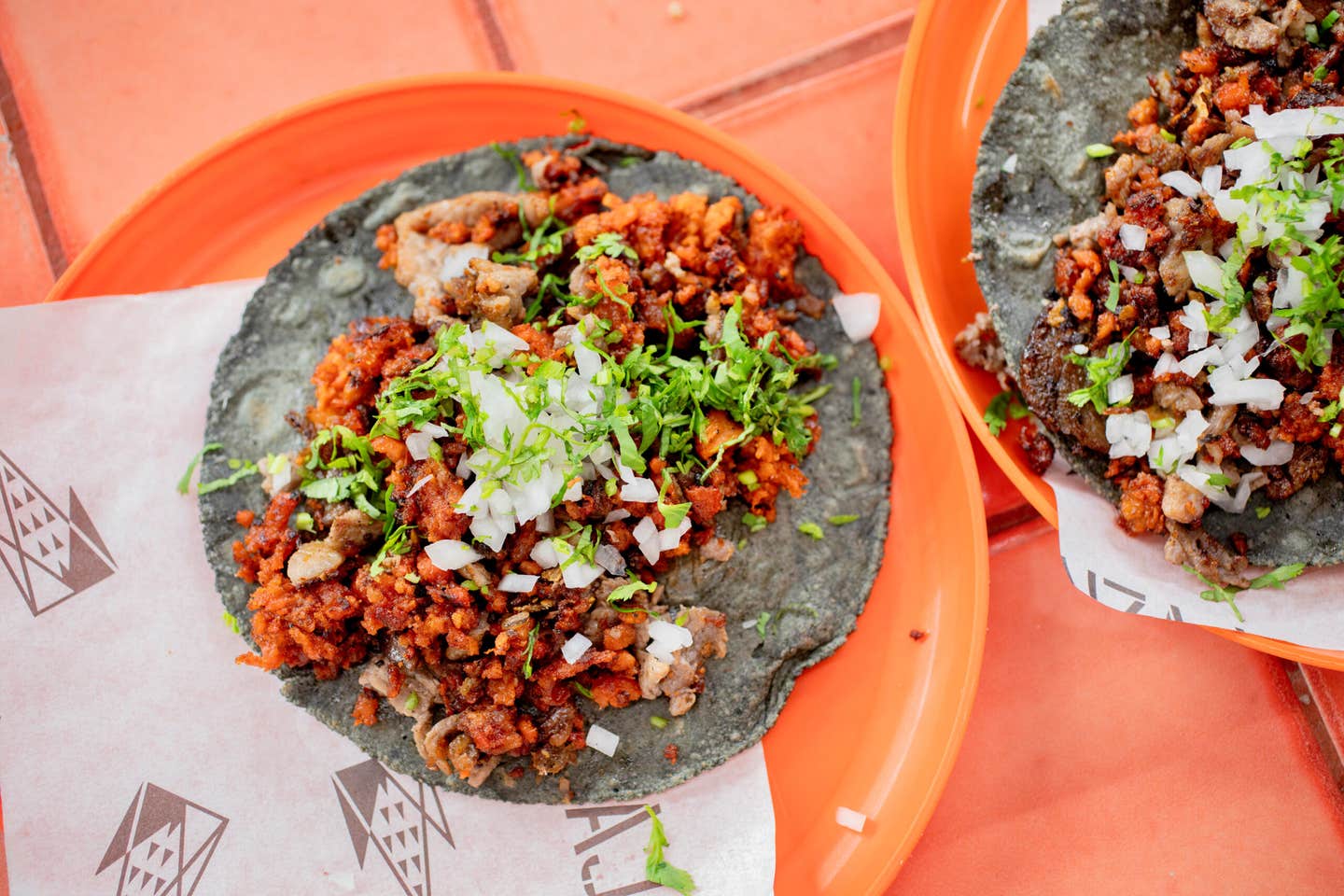
Maizajo, a Condesa hotspot, started out as a tortillería (tortilla factory) on a mission to promote fast-disappearing varieties of heirloom corn. In late 2023 it was expanded to become a restaurant, whose retro-tiled interior pays homage to taquerías of yore. The menu offers well-crafted versions of street-stand classics, including the campechano, a combination of sautéed rib-eye and housemade pork longaniza (a type of chorizo fragrant with chile de árbol). Heaped on a blue corn tortilla and garnished with chopped cilantro and onion, it’s best with a dollop of brick red salsa martajada (grilled tomatoes and chiles). Also worth noting is the grilled eggplant taco, a good plant-based option.
Taco de carnitas de costilla y buche at Amor y Tacos
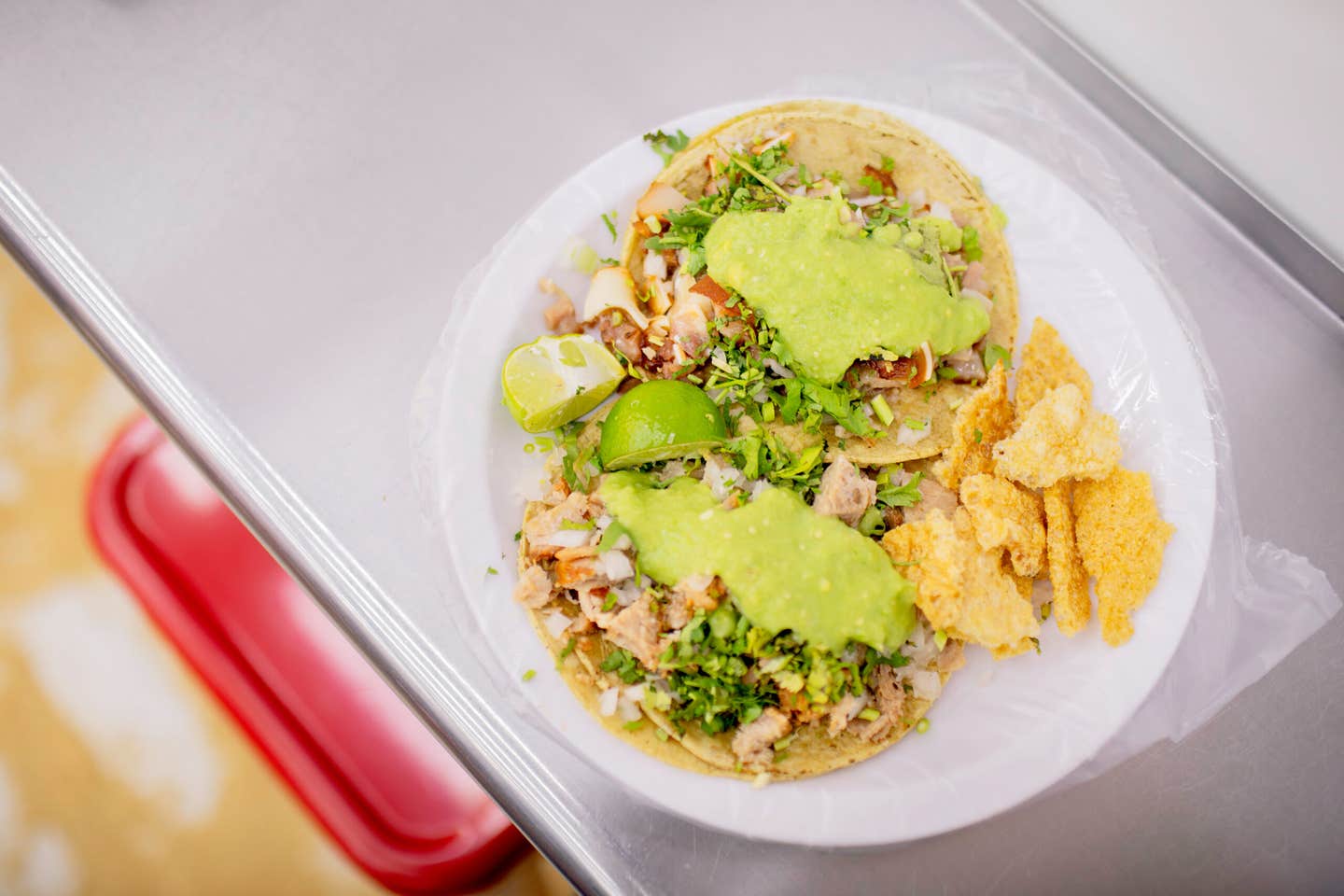
Amor y Tacos’ sign proudly proclaims its age: “Since 1958.” The beloved institution in the historic center recently relocated, but you’d never know it, thanks to the midcentury-style décor complete with sawdust-strewn floors and walls with slogans lauding taco culture: “Mexico is beautiful—Mexico is tacos,” proclaims one. The specialty here is carnitas, the Michoacán dish that’s now found all over the country (and the world). To make it, cooks boil a whole pig, viscera and all, in water perfumed with onion and garlic, then braise the meat in its own fat, confit-style. Tacos are then made to order according to the preferred cuts of meat. I usually order a combo of costilla (spare rib) and buche (stomach) because the ribs have all the flavor but can be dry without the succulent buche, whose melty texture is similar to tripe. Carnitas should be dressed with salsa, cilantro, onion, and an obligatory squeeze of lime.
Taco de jaiba suave at Siembra Taquería
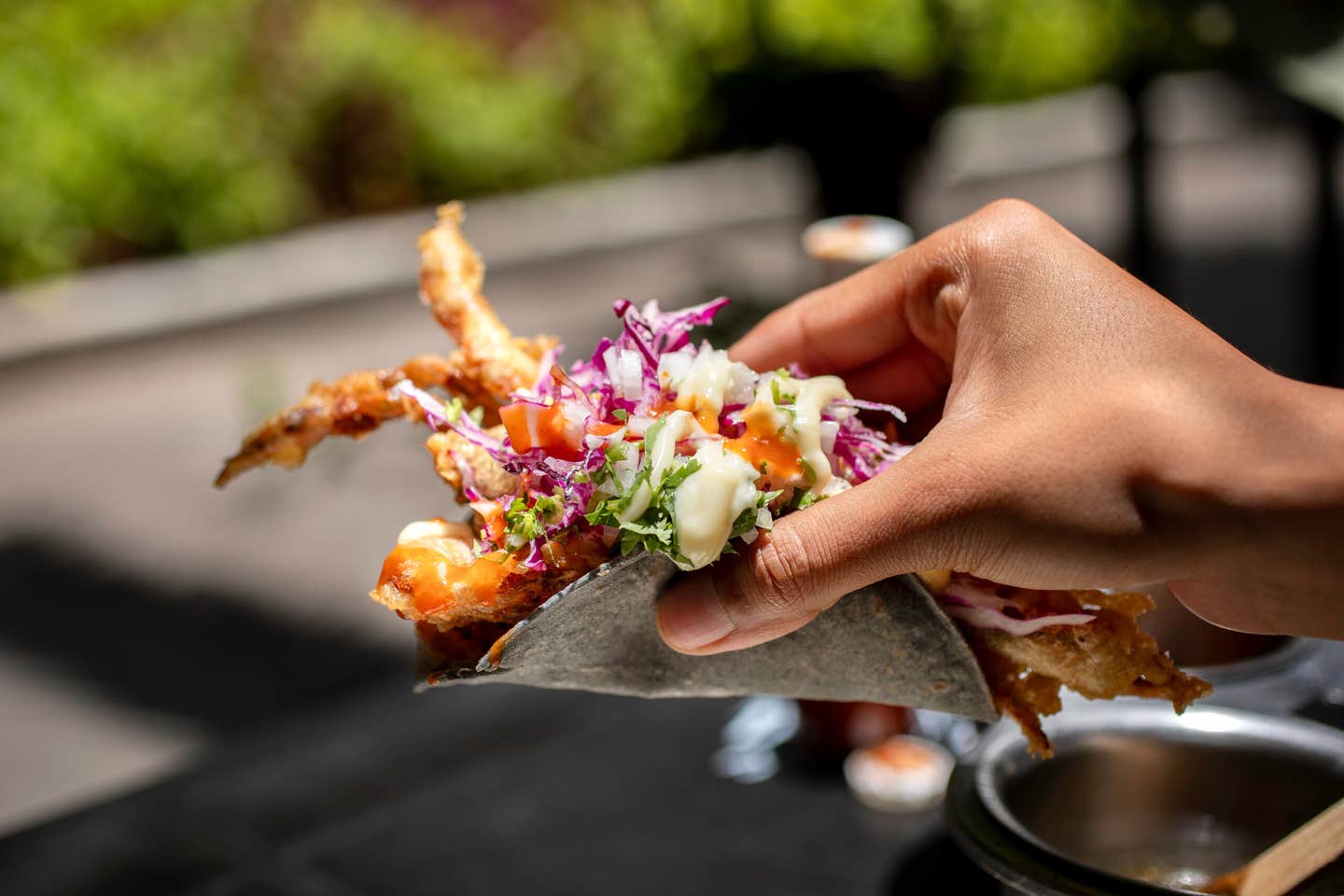
Siembra is the visionary project of chef Israel Montero, formerly of the acclaimed Raíz, who fronts this venue for restaurant versions of classic regional street tacos. The menu includes 20 options, many traditional, others creative, and all come atop tortillas made with local endemic corn. Popular are the cecina (salted dried beef) combined with housemade green chorizo; and the picaña con chicharron, grilled, juicy beef topped with crunchy cracklins. But the sleeper hit here is the deceptively simple jaiba suave (softshell crab), which comes tempura-fried, resting on its blue tortilla like a crispy little cloud. A drizzle of housemade Japanese-style mayo, a crown of shredded red cabbage, and a dash of salsa chiltepín—made from a tiny but potent chile—makes a great thing greater. The compact locale features pleasant outdoor seating under a shady wooden canopy.
Taco de chilorio at La Tonina
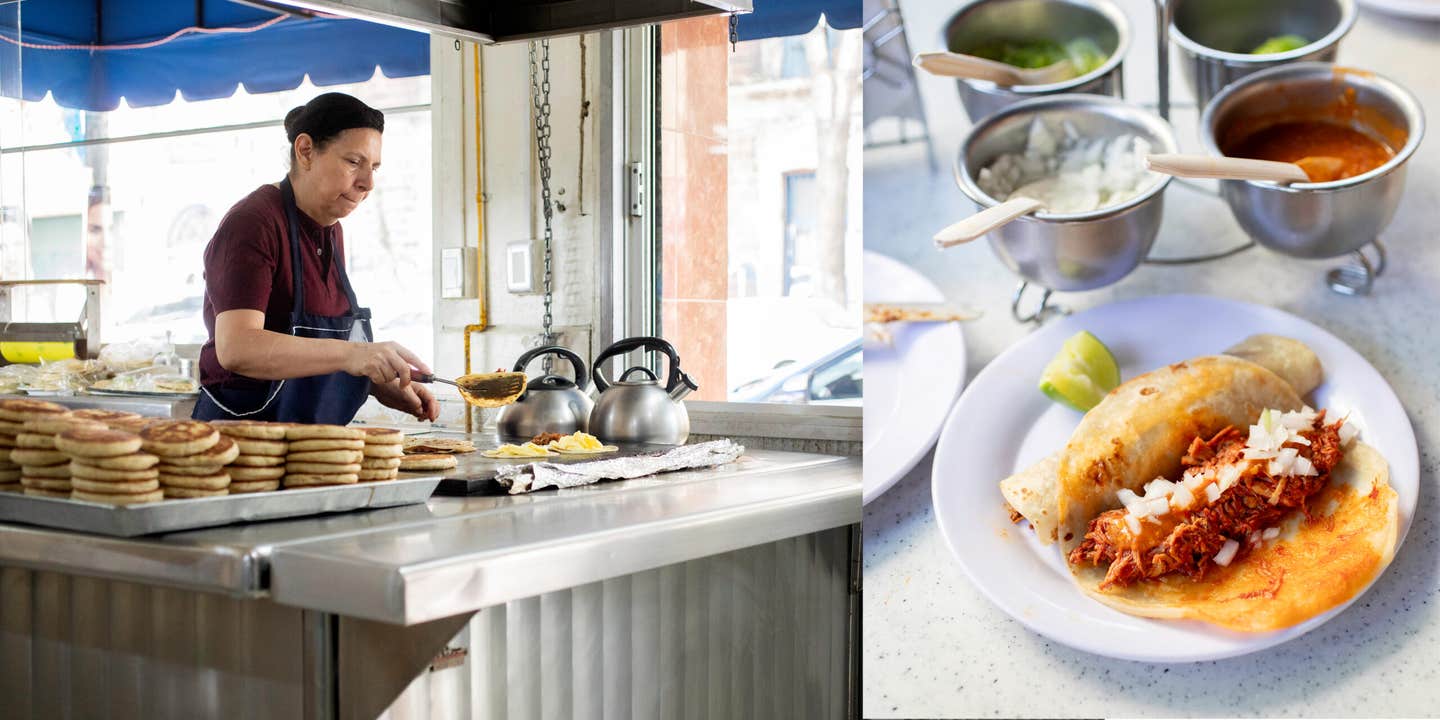
In 1949, Tonina Jackson, a successful lucha libre wrestler, opened this restaurant to rectify the city’s dearth of cooking from the northern states of Sonora, Durango, Nuevo León, and Sinaloa. It was once the after-hours haunt of showbiz luminaries who frequented the spectacular Cine Opera, down the block and now in ruins. The restaurant may have lost its former glamor, but the food still sparkles. Flour tortillas—a rarity in the capital—are made from scratch and served fresh from the griddle. The fillings are beef-based as the north is cattle country. Chilorio, my favorite, reminds me of that Tex-Mex classic, chili con carne. A favorite in the markets of Sinaloa, it’s made with shredded beef, ají colorado, garlic, oregano, cumin, and vinegar.
Taco de chorizo verde at Ricos Tacos Toluca
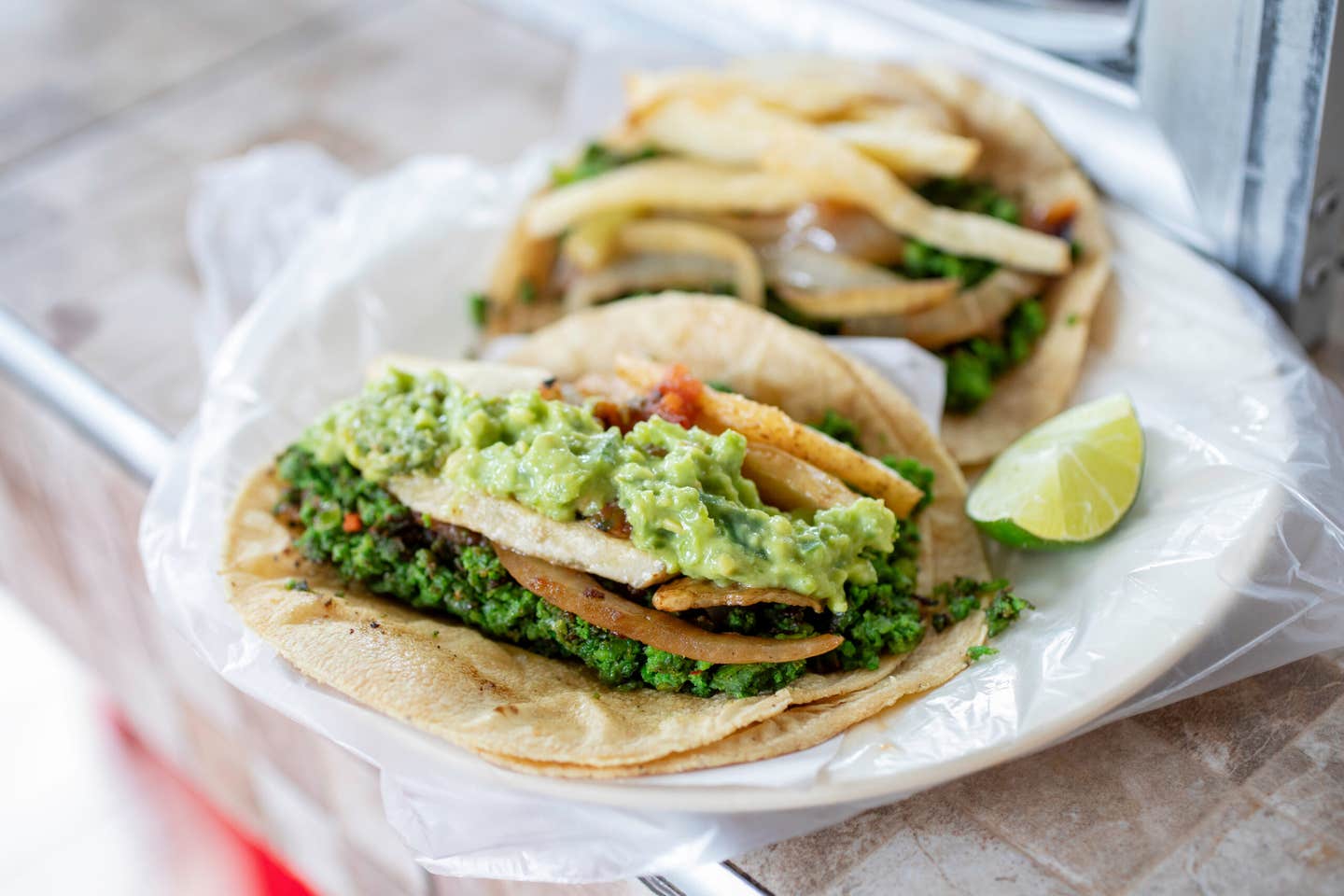
This open-to-the-street, standing-room-only taquería serves up specialties of nearby Toluca and Mexico State, namely, chorizo, cecina (salted dried beef), and obispo (stuffed offal along the lines of haggis) tacos. Red and green sausage links hang like Christmas ornaments above the griddle, and their spicy aroma entices passersby to stop for a tentempié (quick bite). The bright green chorizo verde, made with ground pork, serrano chiles, cilantro, tomatillos, spinach, and pine nuts, reminds this ex–New Yorker of the Italian sausage once proffered in Little Italy. Brightly colored salsas—chile-avocado, fresh pico de gallo, and roast tomato-chile—can be added to each diner’s liking.
Taco de carnitas de buche y barriga at Taquería El Gran Abanico
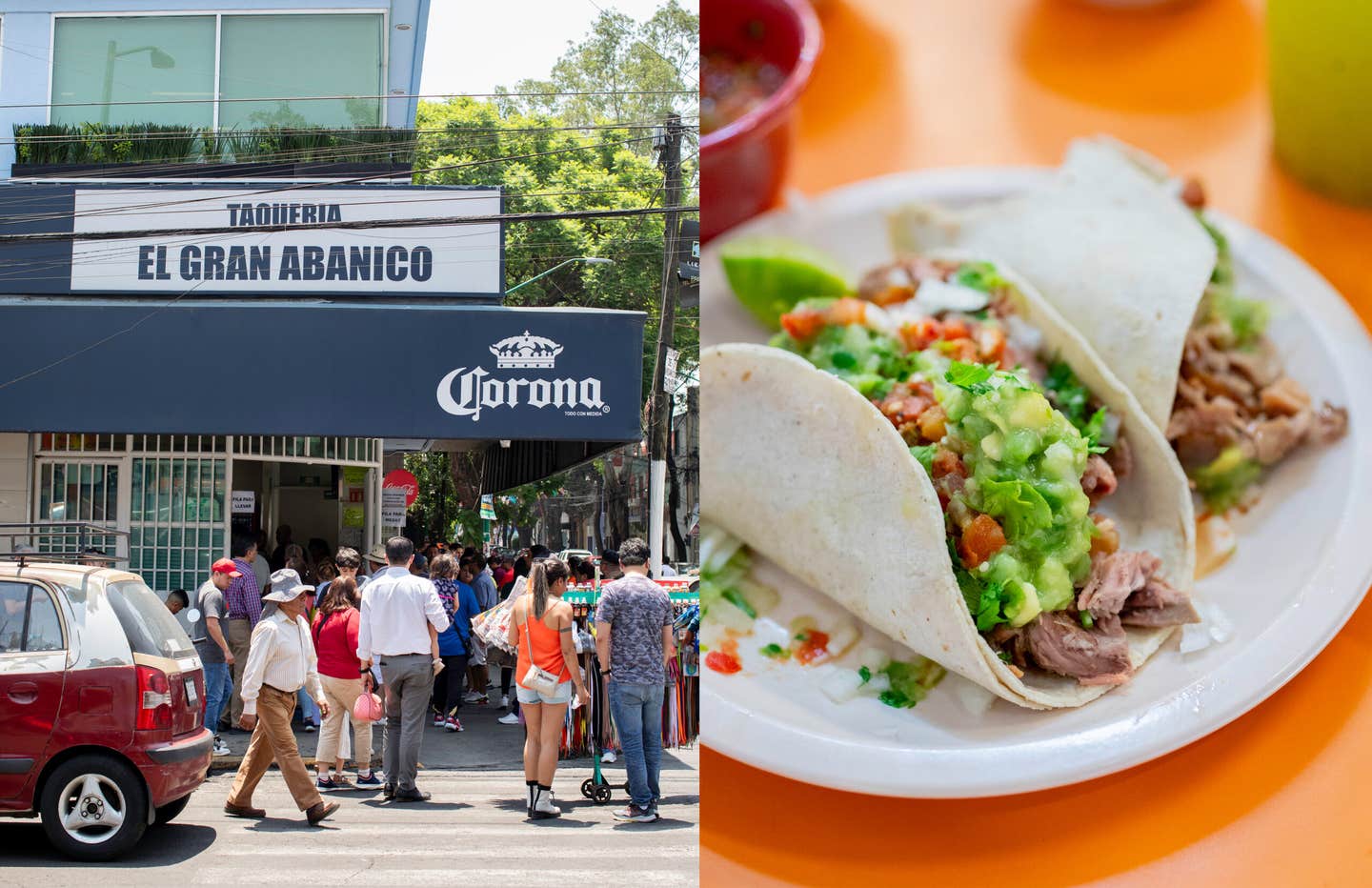
This legendary carnitas purveyor occupies an entire block in the working-class Tránsito neighborhood south of the Centro. It is a pilgrimage site for aficionados of all stripes, who sit in the cavernous interior or spill onto the street to revel in all things pig. While some spring for the taco de maciza (pork loin), I recommend the “buche y barriga hecho a la plancha” (griddled pork belly and stomach). The extra pass on the grill gives the meat a crackly crust and brings out more flavor. Sides of sautéed nopalitos (cactus) and grilled cebollitas (baby onions) round out the proceedings, and a chela (slang for beer) is the perfect accompaniment.
Taco al pastor “negro” at Taquería El Trompo Imperial
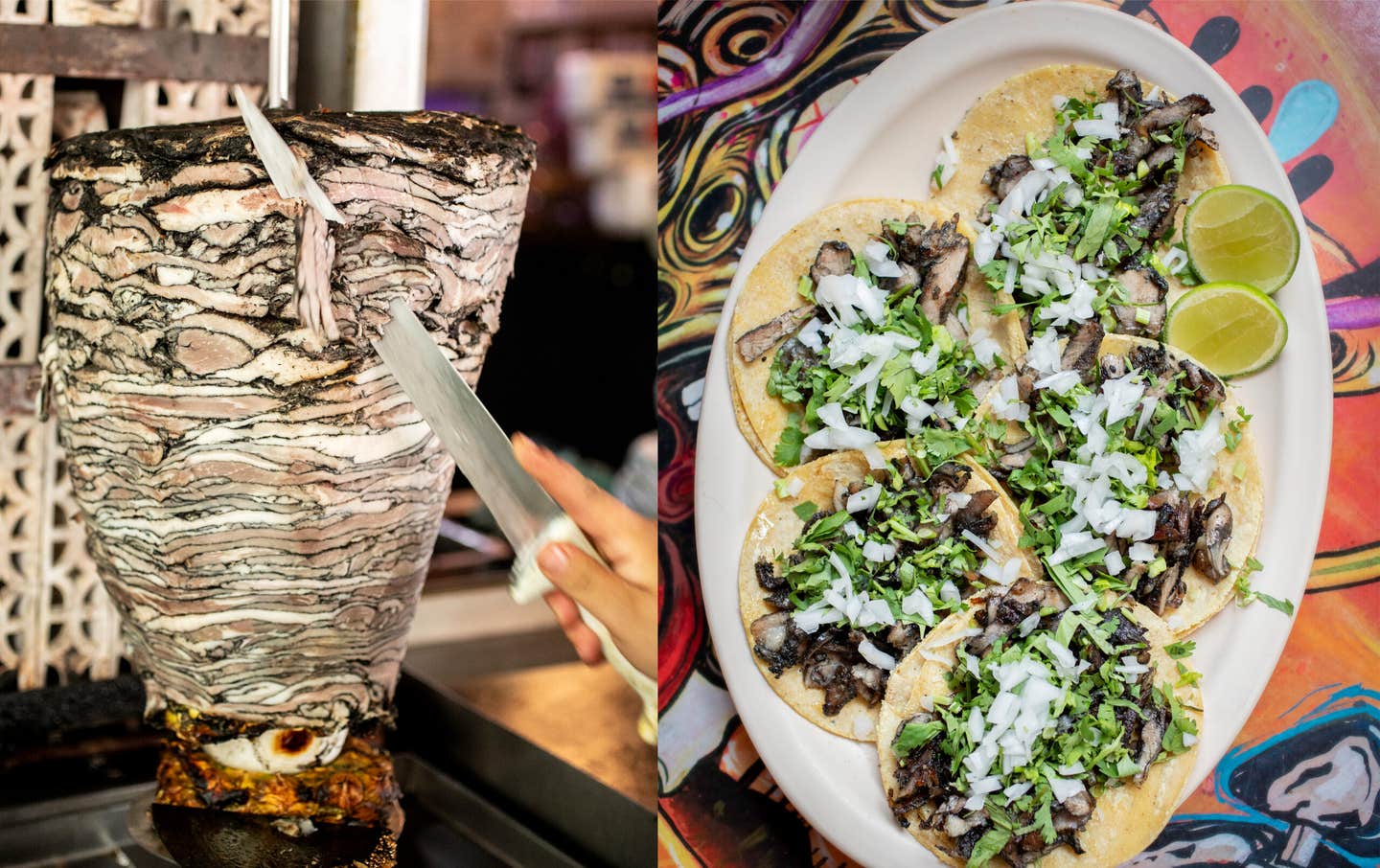
Tacos al pastor, iconic in the capital, are the Mexican interpretation of Middle Eastern shawarma, brought to the country by Lebanese immigrants in the middle of the last century. To make it, thin slices of achiote-marinated pork are stacked onto a trompo (upright skewer). Then, a peeled pineapple is placed on top, and the whole thing is grilled vertically and shaved to order by the pastorero with rhythmic elan. The meat is heaped onto a small tortilla, then topped with cilantro, onions, and salsa. Ex-music promoter and restaurateur Carlos Ruíz is the brains behind this refined neighborhood taquería. His version of al pastor stands out because it’s negro, “extra dark,” thanks to a marinade of smoky charred chilies.
Taco de milanesa de res at Los Milanesos
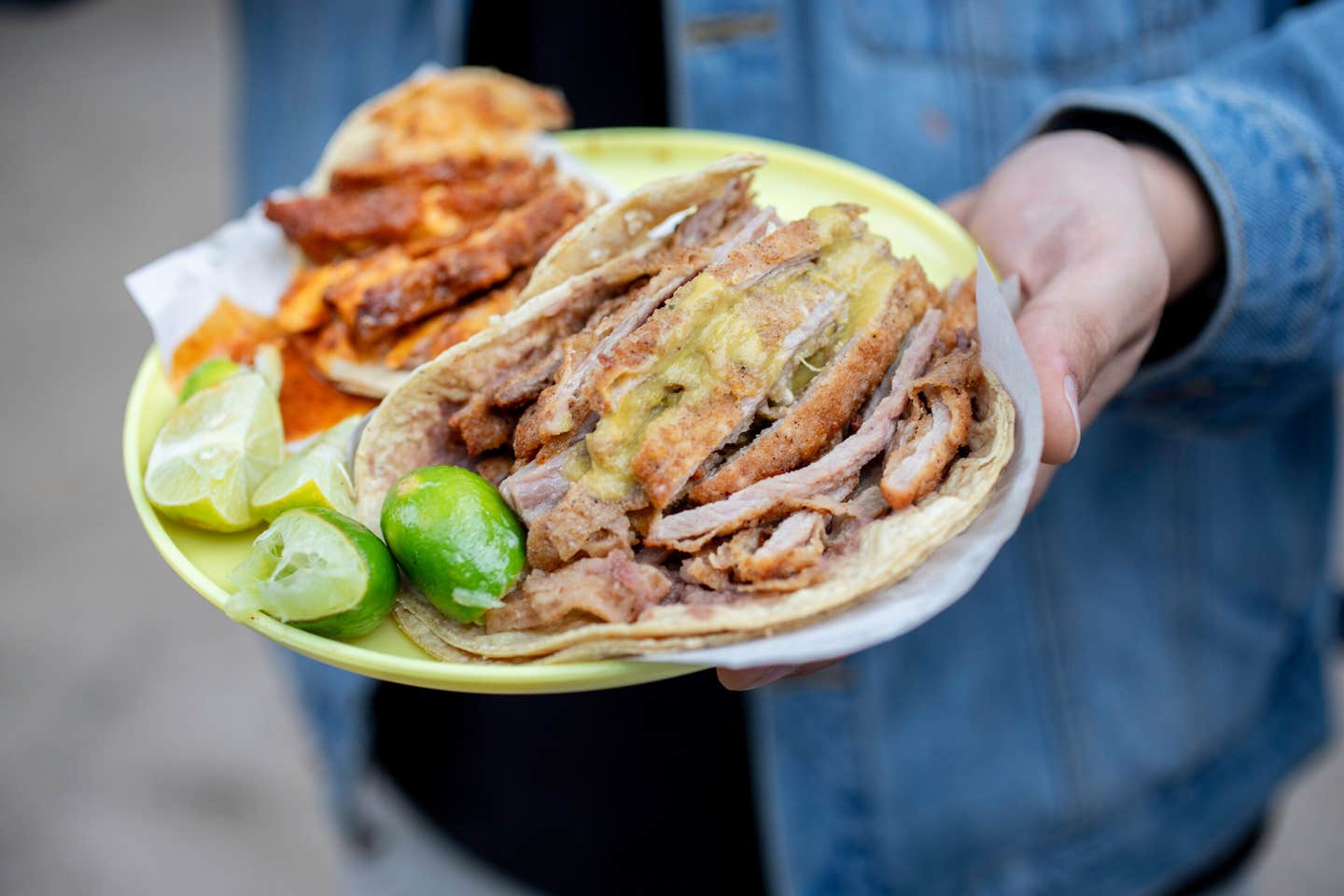
Los Milanesos stands alone—literally and figuratively. It’s located on a grassy strip in what feels like the middle of nowhere in the southwest part of the city, and its milanesa tacos are in a category of their own. Milanesas are breaded deep-fried cutlets of beef or chicken that can be layered with ham and cheese. To turn them into a taco, cooks here slice them into strips and bundle them in a tortilla with a schmear of frijoles refritos. The optional addition of fresh green or roasted tomato-chile salsa lends every bite a welcome zing.
Taco de birria at Birria Las Margaritas
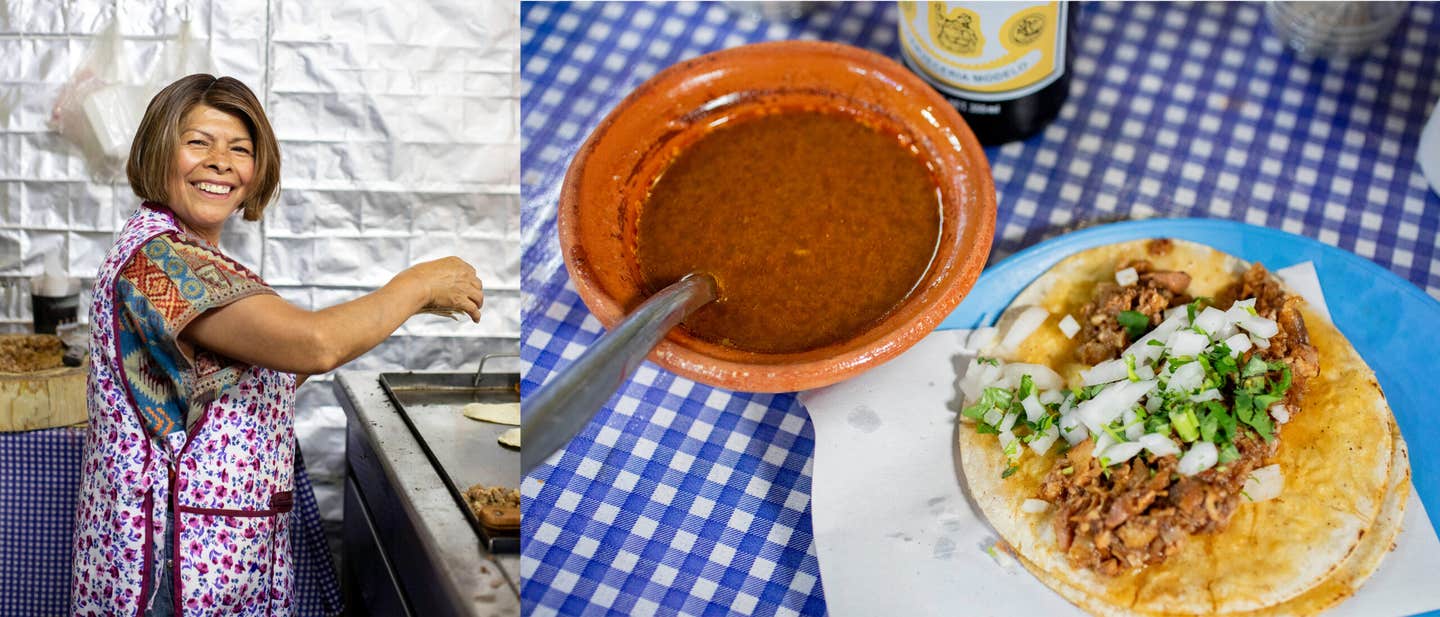
Birria, Jalisco’s signature dish, is a spicy, soupy stew of mutton or beef. It starts with a marinade combining several chiles and spices, such as cumin and oregano. The meat is then wrapped in leaves of the maguey plant (from which mezcal and tequila are extracted) and slow-roasted in pots sealed with corn masa. The dish is a specialty of this unassuming stand, which is run by the Gómez family from Guadalajara, and has just a few tables outside the Merced Market’s main building. Their recipe is a guarded secret, and once you taste the birria tacos garnished with cilantro, onions, and avocado—you’ll understand why. The bowl of accompanying consomé, ladled from a cauldron, is ambrosial with its balanced flavors of beef, chile, and spice.
Taco de pork belly cantonés at Cariñito Tacos
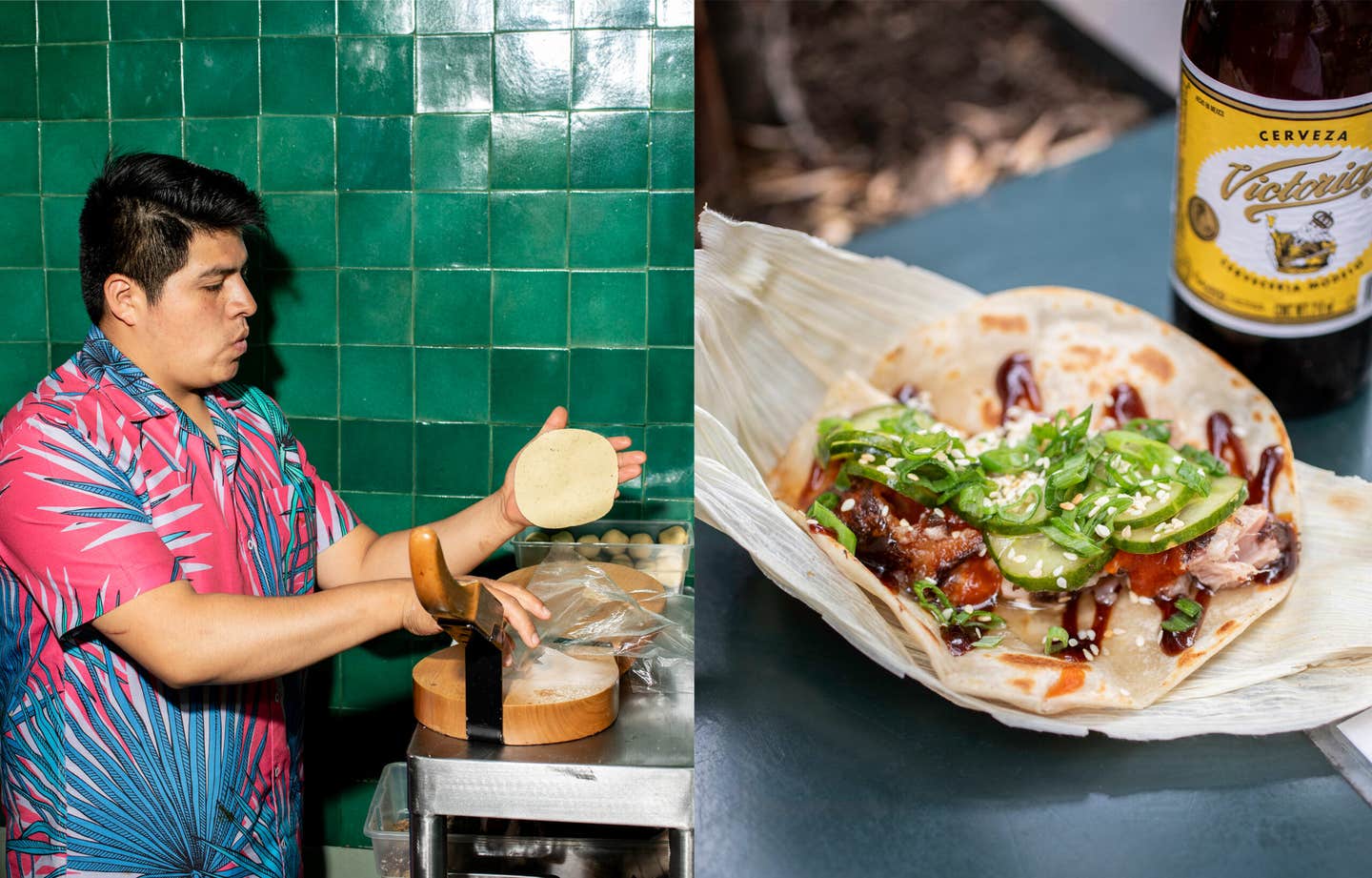
This tiny yet popular restaurant typifies the new breed of modern taquerías whose chefs don’t forsake traditions but add to them, fusing foreign techniques and ingredients with classic Mexican ones. Cariñito offers several types of pork belly tacos (plus a couple of vegetarian options such as grilled eggplant or cauliflower) that incorporate Korean and Chinese ingredients. The Cantonese, my favorite, consists of sous vide pork with a crackly chicharrón crust. It comes sliced and mounded on a housemade flour tortilla slicked with Korean barbecue sauce, then dressed with a chile and tamarind infusion and topped with lemony pickled carrots and turnips. This is Mexican-Asian fusion at its best.
Keep Reading
Continue to Next Story










